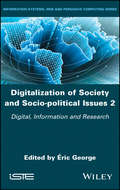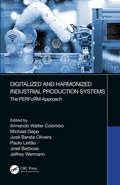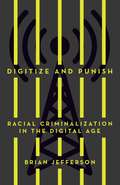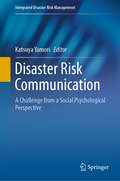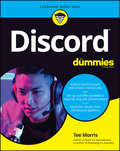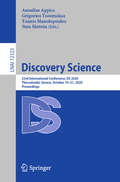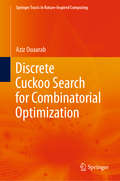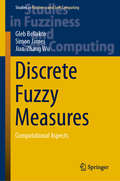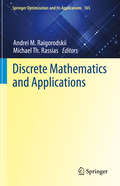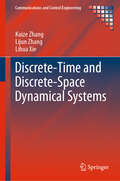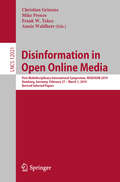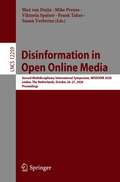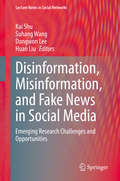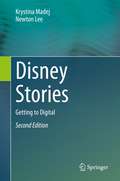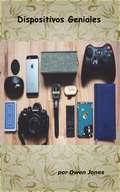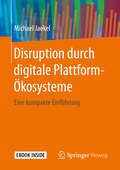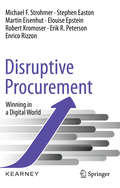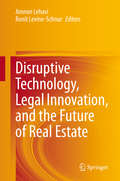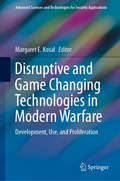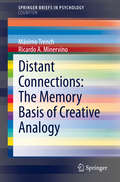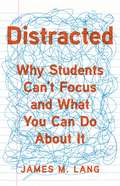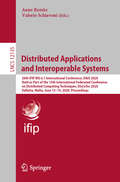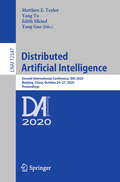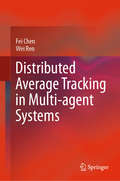- Table View
- List View
Digitalization of Society and Socio-political Issues 2: Digital, Information, and Research
by Éric GeorgeDigitalization is a long socio-historic process in which all areas of society's activities are reconfigured. In the first volume of Digitalization of Society and Socio-political Issues, there is an examination of the transformations linked to the development of digital platforms and social media which affect cultural and communicational industries. The book also analyzes the formation of Big Data, their algorithmic processing and the societal changes which result from them (social monitoring and control in particular). Through diverse critical reflections, it equally presents different ways that digital participates in relations of power and domination, and contributes to eventual emancipatory practices. Following on, the second volume examines the transformations that are linked to digital practices that affect the production, circulation and consumption of information, as well as new forms that are taken by social mobilizations. It treats several important issues in the digital era that are more likely to become the subject of public debates, among which one can include the renewed relationship between research and digital. Through diverse critical reflections, it equally presents different ways that digital participates in relations of power and domination, and contributes to eventual emancipatory practices.
Digitalized and Harmonized Industrial Production Systems: The PERFoRM Approach
by Armando Walter Colombo Michael Gepp José Barata Paulo Leitao José Barbosa Jeffrey WermannOn the one side, Industrial competitiveness today means shorter product lifecycles, increased product variety, and shorter times to market and customized tangible products and services. To face these challenges, the manufacturing industry is forced to move from traditional management, control, and automation approaches towards industrial cyber-physical systems. On the other side, several emergent engineering approaches and related Information‐Communication‐Control‐Technologies, such as Multi‐Agent-Systems, Service‐Oriented Architecture, Plug‐and‐Produce Systems, Cloud and Fog Technologies, Big Data and Analytics, among others, have been researched during the last years. The confluence of those results with the latest developments in Industrial Digitalization, Systems‐of‐Cyber-Physical-Systems Engineering, Internet‐of‐Things, Internet‐of‐Services, and Industry 4.0 is opening a new broad spectrum of innovation possibilities. The PERFoRM (Production-harmonizEd-Reconfiguration of Flexible Robots and Machinery) approach is one of them. It teaches the reader what it means when production machines and systems are digitalized and migrated into Industrial Cyber-Physical Systems and what happens when they are networked and start collaborating with each other and with the human, using the internet. After a Technology Trend Screening and beyond a comprehensive state-of-the-art analysis about Industrial Digitalization and Industry 4.0-compliant solutions, the book introduces methods, architectures, and technologies applicable in real industrial use cases, explained for a broad audience of researchers, practitioners, and industrialists.
Digitize and Punish: Racial Criminalization in the Digital Age
by Brian JeffersonTracing the rise of digital computing in policing and punishment and its harmful impact on criminalized communities of color The U.S. Bureau of Justice Statistics estimates that law enforcement agencies have access to more than 100 million names stored in criminal history databases. In some cities, 80 percent of the black male population is registered in these databases. Digitize and Punish explores the long history of digital computing and criminal justice, revealing how big tech, computer scientists, university researchers, and state actors have digitized carceral governance over the past forty years—with devastating impact on poor communities of color.Providing a comprehensive study of the use of digital technology in American criminal justice, Brian Jefferson shows how the technology has expanded the wars on crime and drugs, enabling our current state of mass incarceration and further entrenching the nation&’s racialized policing and punishment. After examining how the criminal justice system conceptualized the benefits of computers to surveil criminalized populations, Jefferson focuses on New York City and Chicago to provide a grounded account of the deployment of digital computing in urban police departments.By highlighting the intersection of policing and punishment with big data and web technology—resulting in the development of the criminal justice system&’s latest tool, crime data centers—Digitize and Punish makes clear the extent to which digital technologies have transformed and intensified the nature of carceral power.
Disaster Risk Communication: A Challenge from a Social Psychological Perspective (Integrated Disaster Risk Management)
by Katsuya YamoriThis book provides a unique blend of integrated disaster risk communication research conducted by authors with diverse backgrounds, including social psychology, sociology, civil engineering, informatics, and meteorology. It reports on the latest advances in collaborative and participatory action research on community-based disaster management from the frontline in Japan, Nepal, China and the USA. In addition, it employs and integrate a broad range of methodologies, including mathematical analyses, computer simulations, questionnaire surveys, gaming approaches, and participatory observation. Each chapter deals with disaster risk communication initiatives to address various hazards, such as earthquakes, tsunamis, floods and landslides, which are uniquely integrated from a social psychological perspective.
Discord For Dummies
by Tee MorrisBuild a Discord studio and create a community Set up a profile, establish a channel, and join conversations Maximize results from the Discord platform Harmonize with your audience on Discord This evolving digital age offers numerous options for instant communications. Discord has emerged as a major player in connecting people from all parts of the world via text, audio, and video. Originally favored by the online gaming community, Discord now attracts content creators of all backgrounds eager to cultivate communities around all types of topics. Written by an expert in personal broadcasting for business or pleasure, the book is ideal for anyone looking to connect with a larger audience. Inside... Set up your profile Establish a server Join conversations Play by the rules Build a studio Create a community Apply Discord to your daily routine
Discovery Science: 23rd International Conference, DS 2020, Thessaloniki, Greece, October 19–21, 2020, Proceedings (Lecture Notes in Computer Science #12323)
by Yannis Manolopoulos Annalisa Appice Stan Matwin Grigorios TsoumakasThis book constitutes the proceedings of the 23rd International Conference on Discovery Science, DS 2020, which took place during October 19-21, 2020. The conference was planned to take place in Thessaloniki, Greece, but had to change to an online format due to the COVID-19 pandemic. The 26 full and 19 short papers presented in this volume were carefully reviewed and selected from 76 submissions. The contributions were organized in topical sections named: classification; clustering; data and knowledge representation; data streams; distributed processing; ensembles; explainable and interpretable machine learning; graph and network mining; multi-target models; neural networks and deep learning; and spatial, temporal and spatiotemporal data.
Discrete Cuckoo Search for Combinatorial Optimization (Springer Tracts in Nature-Inspired Computing)
by Aziz OuaarabThis book provides a literature review of techniques used to pass from continuous to combinatorial space, before discussing a detailed example with individual steps of how cuckoo search (CS) can be adapted to solve combinatorial optimization problems. It demonstrates the application of CS to three different problems and describes their source code. The content is divided into five chapters, the first of which provides a technical description, together with examples of combinatorial search spaces. The second chapter summarizes a diverse range of methods used to solve combinatorial optimization problems. In turn, the third chapter presents a description of CS, its formulation and characteristics. In the fourth chapter, the application of discrete cuckoo search (DCS) to solve three POCs (the traveling salesman problem, quadratic assignment problem and job shop scheduling problem) is explained, focusing mainly on a reinterpretation of the terminology used in CS and its source of inspiration. In closing, the fifth chapter discusses random-key cuckoo search (RKCS) using random keys to represent positions found by cuckoo search in the TSP and QAP solution space.
Discrete Fuzzy Measures: Computational Aspects (Studies in Fuzziness and Soft Computing #382)
by Simon James Gleb Beliakov Jian-Zhang WuThis book addresses computer scientists, IT specialists, mathematicians, knowledge engineers and programmers, who are engaged in research and practice of multicriteria decision making. Fuzzy measures, also known as capacities, allow one to combine degrees of preferences, support or fuzzy memberships into one representative value, taking into account interactions between the inputs. The notions of mutual reinforcement or redundancy are modeled explicitly through coefficients of fuzzy measures, and fuzzy integrals, such as the Choquet and Sugeno integrals combine the inputs. Building on previous monographs published by the authors and dealing with different aspects of aggregation, this book especially focuses on the Choquet and Sugeno integrals. It presents a number of new findings concerning computation of fuzzy measures, learning them from data and modeling interactions. The book does not require substantial mathematical background, as all the relevant notions are explained. It is intended as concise, timely and self-contained guide to the use of fuzzy measures in the field of multicriteria decision making.
Discrete Mathematics and Applications (Springer Optimization and Its Applications #165)
by Michael Th. Rassias Andrei M. RaigorodskiiAdvances in discrete mathematics are presented in this book with applications in theoretical mathematics and interdisciplinary research. Each chapter presents new methods and techniques by leading experts. Unifying interdisciplinary applications, problems, and approaches of discrete mathematics, this book connects topics in graph theory, combinatorics, number theory, cryptography, dynamical systems, finance, optimization, and game theory. Graduate students and researchers in optimization, mathematics, computer science, economics, and physics will find the wide range of interdisciplinary topics, methods, and applications covered in this book engaging and useful.
Discrete-Time and Discrete-Space Dynamical Systems (Communications and Control Engineering)
by Lihua Xie Lijun Zhang Kuize ZhangDiscrete-Time and Discrete-Space Dynamical Systems provides a systematic characterization of the similarities and differences of several types of discrete-time and discrete-space dynamical systems, including:Boolean control networks;nondeterministic finite-transition systems;finite automata;labelled Petri nets; andcellular automata.The book's perspective is primarily based on topological properties though it also employs semitensor-product and graph-theoretic methods where appropriate. It presents a series of fundamental results: invertibility, observability, detectability, reversiblity, etc., with applications to systems biology.Academic researchers with backgrounds in applied mathematics, engineering or computer science and practising engineers working with discrete-time and discrete-space systems will find this book a helpful source of new understanding for this increasingly important class of systems. The basic results to be found within are of fundamental importance for further study of related problems such as automated synthesis and safety control in cyber-physical systems using formal methods.
Disinformation in Open Online Media: First Multidisciplinary International Symposium, MISDOOM 2019, Hamburg, Germany, February 27 – March 1, 2019, Revised Selected Papers (Lecture Notes in Computer Science #12021)
by Christian Grimme Mike Preuss Frank W. Takes Annie WaldherrThis book constitutes the refereed proceedings of the First Multidisciplinary International Symposium, MISDOOM 2019, held in Hamburg, Germany, in February/March 2019. The 14 revised full papers were carefully reviewed and selected from 21 submissions. The papers are organized in topical sections named: human computer interaction and disinformation, automation and disinformation, media and disinformation.
Disinformation in Open Online Media: Second Multidisciplinary International Symposium, MISDOOM 2020, Leiden, The Netherlands, October 26–27, 2020, Proceedings (Lecture Notes in Computer Science #12259)
by Mike Preuss Max Van Duijn Viktoria Spaiser Frank Takes Suzan VerberneThis book constitutes the refereed proceedings of the Second Multidisciplinary International Symposium, MISDOOM 2020, held in Leiden, The Netherlands, in October 2020.* The 18 full papers were carefully reviewed and selected from 23 submissions. The papers deal with the interdisciplinary field of computational social science, and in particular with the automated detection and combat of misinformation using modern techniques from machine learning, text mining, and social network analysis. * The conference was held virtually due to the COVID-19 pandemic. Chapters “Identifying Political Sentiments on YouTube: A Systematic Comparison regarding the Accuracy of Recurrent Neural Network and Machine Learning Models” and “Do Online Trolling Strategies Differ in Political and Interest Forums: Early Results” are available open access under a Creative Commons Attribution 4.0 International License via link.springer.com.
Disinformation, Misinformation, and Fake News in Social Media: Emerging Research Challenges and Opportunities (Lecture Notes in Social Networks)
by Huan Liu Dongwon Lee Kai Shu Suhang WangThis book serves as a convenient entry point for researchers, practitioners, and students to understand the problems and challenges, learn state-of-the-art solutions for their specific needs, and quickly identify new research problems in their domains. The contributors to this volume describe the recent advancements in three related parts: (1) user engagements in the dissemination of information disorder; (2) techniques on detecting and mitigating disinformation; and (3) trending issues such as ethics, blockchain, clickbaits, etc. This edited volume will appeal to students, researchers, and professionals working on disinformation, misinformation and fake news in social media from a unique lens.
Disloyal: The True Story of the Former Personal Attorney to President Donald J. Trump
by Michael CohenOnce Donald Trump’s fiercest surrogate, closest confidant, and staunchest defender, Michael Cohen knows where the skeletons are buried. <p><p> This is the most devastating business and political horror story of the century. As Trump’s lawyer and “fixer,” Cohen not only witnessed firsthand but was also an active participant in the inner workings of Trump’s business empire, political campaign, and presidential administration. <p> This is a story that you have not read in newspapers, or on social media, or watched on television. These are accounts that only someone who worked for Trump around the clock for over a decade—not a few months or even a couple of years—could know. Cohen describes Trump’s racist rants against President Barack Obama, Nelson Mandela, and Black and Hispanic people in general, as well as the cruelty, humiliation, and abuse he leveled at family and staff. Whether he’s exposing the fact that Trump engaged in tax fraud by inflating his wealth or electronic fraud by rigging an online survey, or outing Trump’s Neanderthal views towards women or his hush-money payments to clandestine lovers, Cohen pulls no punches. <p> He shows Trump’s relentless willingness to lie, exaggerate, mislead, or manipulate. Trump emerges as a man without a soul—a man who courts evangelicals and then trashes them, panders to the common man, but then rips off small business owners, a con man who will do or say absolutely anything to win, regardless of the cost to his family, his associates, or his country. <p> At the heart of Disloyal, we see how Cohen came under the spell of his charismatic "Boss" and, as a result, lost all sense of his moral compass. <p> The real "real" Donald Trump who permeates these pages—the racist, sexist, homophobic, lying, cheating President—will be discussed, written about, and analyzed for years to come.<p> <b>A New York Times Bestseller</b>
Disney Stories: Getting to Digital
by Newton Lee Krystina MadejThe second edition of Disney Stories: Getting to Digital will be of interest to lovers of Disney history and also to lovers of Hollywood history in general. The first edition was planned as a short history of the companies evolution from analog storytelling to a digital online presence that closed the chapter on early Disney films with the release of the groundbreaking Snow White. The purpose of the new edition is to bring to readers a more complete view of the analog-digital story by including three new chapters on film that cover key developments from the live-animation hybrids of the 1940s to CAPS and CGI in the 1990s and VR in the 2010s. It also includes in the discussion of cross-media storytelling the acquisition of the exceptional story property, Star Wars, and discusses how Disney has brought the epic into the Disney Master Narrative by creating Galaxy’s Edge in its US theme parks.Krystina Madej’s engaging portrayal of the long history of Disney’s love affair with storytelling and technology brings to life the larger focus of innovation in creating characters and stories that captivate an audience, and together with Newton Lee’s detailed experience of Disney during the crucial 1995-2005 era when digital innovation in online and games was at its height in the company, makes for a fast-paced captivating read.Disney Stories first edition explored the history of Disney, both analog and digital. It described in detail how Walt Disney used inventive and often ground-breaking approaches in the use of sound, color, depth, and the psychology of characters to move the animation genre from short visual gags to feature-length films with meaningful stories that engaged audience's hearts as well as tickled their funny bones. It showed Walt’s comprehensive approach to engaging the public across all media as he built the Disney Master Narrative by using products, books, comics, public engagements, fan groups such as the Mickey Mouse club, TV, and, of course, Disneyland, his theme park. Finally it showed how, after his passing, the company continued to embrace Walt’s enthusiasm for using new technology to engage audiences through their commitment to innovation in digital worlds. It describes in detail the innovative storybook CD-ROMs, their extensive online presence, the software they used and created for MMORGs such as Toontown, and the use of production methods such as agile methodology. This new edition provides insight on major developments in Disney films that moved them into the digital world.
Dispositivos geniales (Como hacer... #28)
by Owen JonesDispositivos geniales Hola y gracias por comprar este libro llamado “Dispositivos Geniales”. Espero que la información que encuentres en él te sea de ayuda, te sea útil y rentable. La información en este libro sobre varios tipos de dispositivos, juguetes para adultos y temas relacionados está organizada en 16 capítulos de unas 500-600 palabras cada uno. Espero que le interese a aquellas personas que les gusta la tecnología moderna y dispositivos. Como un bono adicional, les daré permiso para que usen el contenido en sus propias páginas web o en sus blogs y boletines informativos, aunque sería mejor si las reescriben con sus propias palabras. También pueden dividir el libro y vender los artículos. De hecho, el único derecho que no tienen es de revender o distribuir el libro tal y como ustedes lo reciben. Si tienes algún comentario, por favor déjalo con la compañía de donde compraste el libro, y también puedes ubicar más libros como este ahí. Gracias de nuevo por comprar este libro, Saludos, Owen Jones
Disruption durch digitale Plattform-Ökosysteme: Eine kompakte Einführung
by Michael JaekelDisruption ist das Schlagwort einer Digitalmoderne, in der digitale Plattform-Ökosysteme eine neue Ökonomie erzeugen. Es expandiert eine Plattform-Ökonomie, die etablierte Unternehmen und Industrien in ihren Grundfesten erschüttert. Die Erschütterungen werden von dem Phänomen der Disruption ausgelöst. In Literatur und Praxis wird der Begriff der Disruption aber inflationär für nahezu alles herangezogen. Daher zielt das vorliegende kompakte Buch auf die kohärente Klärung des Begriffs der Disruption als ein Axiom der Digitalmoderne ab. Zudem erläutert der Autor die Expansionsdynamiken digitaler Plattform-Öko-Systeme durch Big Data-Management und Anwendungen der schwachen Künstlichen Intelligenz. Die Ausführungen zeigen die Relevanz der Disruptionstheorie praxisorientiert am Beispiel der digitalen Transformation eines großen Verlagshauses. Der Autor bietet mit seinem Werk Denkwerkzeuge und -anregungen, jedoch keinen schablonenhaften Ratgeber. Damit richtet sich das Buch an alle, die sich mit disruptiven Dynamiken der Digitalisierung kritisch auseinandersetzen und eigene Gedanken weiterentwickeln möchten.
Disruptive Procurement: Winning in a Digital World
by Michael F. Strohmer Stephen Easton Robert Kromoser Martin Eisenhut Elouise Epstein Erik R. Peterson Enrico RizzonDisruptive Procurement is a radical new approach to creating value and innovation by challenging the status quo in the entire product and service line. It requires going far beyond conventional desktop procurement to understand the value the company brings to its customers as well as the value that suppliers bring to the company. By combining knowledge of these two dimensions, companies become far more flexible and they move closer to disrupting the environment in ways that create value. To move toward Disruptive Procurement, companies need a holistic view and a complete new set of capabilities for staff in marketing, sales, R&D, manufacturing, innovation, and, of course, procurement. This will only happen if procurement is fully backed by the Chief Executive Officer and companies embrace digital tools that will help make procurement slimmer and smarter.
Disruptive Technology, Legal Innovation, and the Future of Real Estate
by Amnon Lehavi Ronit Levine-SchnurThis book addresses challenges that new technologies and the big data revolution pose to existing regulatory and legal frameworks. The volume discusses issues such as blockchain and its implications for property transactions and taxes, three (or four) dimensional title registration, land use and urban planning in the age of big data, and the future of property rights in light of these changes. The book brings together an interdisciplinary collection of chapters that revolve around the potential influence of disruptive technologies on existing legal norms and the future development of real estate markets. The book is divided into five parts. Part I presents a survey of the current available research on blockchain and real estate. Part II provides a background on property law for the volume, grounding it in fundamental theory. Part III discusses the changing landscapes of property rights while Part IV debates the potential effects of blockchain on land registration. Finally the book concludes with Part V, which is devoted to new technological applications relevant to real estate. Providing an interdisciplinary perspective on emerging technologies that have the potential to disrupt the real estate industry and the regulation of it, this book will appeal to a broad audience, consisting of scholars, policy-makers, practitioners, and students, interested in real estate, law, economics, blockchain, and technology policy.
Disruptive and Game Changing Technologies in Modern Warfare: Development, Use, and Proliferation (Advanced Sciences and Technologies for Security Applications)
by Margaret E. KosalThis book explores and analyzes emerging innovations within today’s most cutting-edge science and technology (S&T) areas, which are cited as carrying the potential to revolutionize governmental structures, economies, and international security. Some have argued that such technologies will yield doomsday scenarios and that military applications of such technologies have even greater potential than nuclear weapons to radically change the balance of power. As the United States looks to the future – whether dominated by extremist groups co-opting advanced weapons in the world of globalized non-state actors or states engaged in persistent regional conflicts in areas of strategic interest – new adversaries and new science and technology will emerge. Choices made today that affect science and technology will impact how ably the US can and will respond. Chapters within the book look at the changing strategic environment in which security operations are planned and conducted; how these impact science and technology policy choices made today; and predictions of how science and technology may play a beneficial or deleterious role in the future. Some game changing technologies have received global attention, while others may be less well known; the new technologies discussed within this proposal, as well as future discoveries, may significantly alter military capabilities and may generate new threats against military and civilian sectors.
Distant Connections: The Memory Basis of Creative Analogy (SpringerBriefs in Psychology)
by Máximo Trench Ricardo A. MinervinoAnalogical thinking lies at the core of human cognition, pervading from the most mundane to the most extraordinary forms of creativity. By connecting poorly understood phenomena to learned situations whose structure is well articulated, it allows reasoners to expand the boundaries of their knowledge. The first part of the book begins by fleshing out the debate around whether our cognitive system is well-suited for creative analogizing, and ends by reviewing a series of studies that were designed to decide between the experimental and the naturalistic accounts. The studies confirm the psychological reality of the surface bias revealed by most experimental studies, thus claiming for realistic solutions to the problem of inert knowledge. The second part of the book delves into cognitive interventions, while maintaining an emphasis on the interplay between psychological modeling and instructional applications. It begins by reviewing the first generation of instructional interventions aimed at improving the later retrievability of educational contents by highlighting their abstract structure. Subsequent chapters discuss the most realistic avenues for devising easily-executable and widely-applicable ways of enhancing access to stored knowledge that would otherwise remain inert. The authors review results from studies from both others and their own lab that speak of the promise of these approaches.
Distracted: Why Students Can't Focus and What You Can Do About It
by James M. LangKeeping students focused can be difficult in a world filled with distractions -- which is why a renowned educator created a scientific solution to one of every teacher's biggest problems.Why is it so hard to get students to pay attention? Conventional wisdom blames iPhones, insisting that access to technology has ruined students' ability to focus. The logical response is to ban electronics in class. But acclaimed educator James M. Lang argues that this solution obscures a deeper problem: how we teach is often at odds with how students learn. Classrooms are designed to force students into long periods of intense focus, but emerging science reveals that the brain is wired for distraction. We learn best when able to actively seek and synthesize new information. In Distracted, Lang rethinks the practice of teaching, revealing how educators can structure their classrooms less as distraction-free zones and more as environments where they can actively cultivate their students' attention. Brimming with ideas and grounded in new research, Distracted offers an innovative plan for the most important lesson of all: how to learn.
Distributed Applications and Interoperable Systems: 20th IFIP WG 6.1 International Conference, DAIS 2020, Held as Part of the 15th International Federated Conference on Distributed Computing Techniques, DisCoTec 2020, Valletta, Malta, June 15–19, 2020, Proceedings (Lecture Notes in Computer Science #12135)
by Anne Remke Valerio SchiavoniThis book constitutes the proceedings of the 20th IFIP International Conference on Distributed Applications and Interoperable Systems, DAIS 2020, which was supposed to be held in Valletta, Malta, in June 2020, as part of the 15th International Federated Conference on Distributed Computing Techniques, DisCoTec 2020. The conference was held virtually due to the COVID-19 pandemic. The 10 full papers presented together with 1 short paper and 1 invited paper were carefully reviewed and selected from 17 submissions. The papers addressed challenges in multiple application areas, such as privacy and security, cloud and systems, fault-tolerance and reproducibility, machine learning for systems, and distributed algorithms.
Distributed Artificial Intelligence: Second International Conference, DAI 2020, Nanjing, China, October 24–27, 2020, Proceedings (Lecture Notes in Computer Science #12547)
by Yang Gao Yang Yu Matthew E. Taylor Edith ElkindThis book constitutes the refereed proceedings of the Second International Conference on Distributed Artificial Intelligence, DAI 2020, held in Nanjing, China, in October 2020. The 9 full papers presented in this book were carefully reviewed and selected from 22 submissions. DAI aims at bringing together international researchers and practitioners in related areas including general AI, multiagent systems, distributed learning, computational game theory, etc., to provide a single, high-profile, internationally renowned forum for research in the theory and practice of distributed AI. Due to the Corona pandemic this event was held virtually.
Distributed Average Tracking in Multi-agent Systems
by Fei Chen Wei RenThis book presents a systematic study of an emerging field in the development of multi-agent systems. In a wide spectrum of applications, it is now common to see that multiple agents work cooperatively to accomplish a complex task. The book assists the implementation of such applications by promoting the ability of multi-agent systems to track — using local communication only — the mean value of signals of interest, even when these change rapidly with time and when no individual agent has direct access to the average signal across the whole team; for example, when a better estimation/control performance of multi-robot systems has to be guaranteed, it is desirable for each robot to compute or track the averaged changing measurements of all the robots at any time by communicating with only local neighboring robots. The book covers three factors in successful distributed average tracking: algorithm design via nonsmooth and extended PI control;distributed average tracking for double-integrator, general-linear, Euler–Lagrange, and input-saturated dynamics; andapplications in dynamic region-following formation control and distributed convex optimization. The book presents both the theory and applications in a general but self-contained manner, making it easy to follow for newcomers to the topic. The content presented fosters research advances in distributed average tracking and inspires future research directions in the field in academia and industry.
